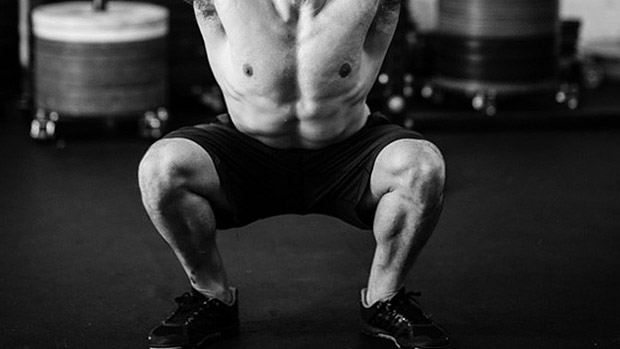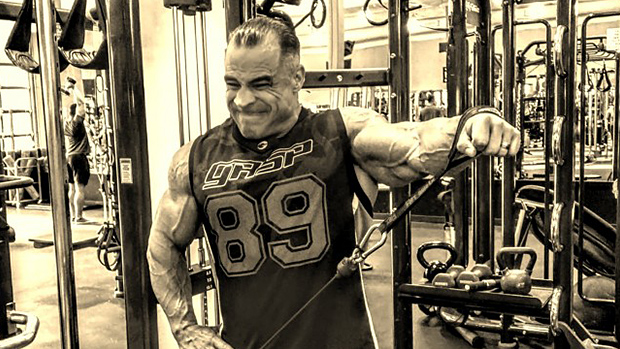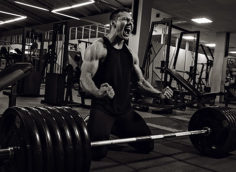Make no mistake about it, hand to hand combat has been around for as long as Testosterone has poured through the bloodstream of Homo sapiens.
That's because you and I are designed with one sole purpose in mind: survival. So no matter how paradoxical it might seem, red-blooded males have an innate, and sometimes intense, desire to grapple with others in hopes that we'll somehow become more apt to survive nature and all its beasts.
Or maybe we just think that proficient ass-whoopin' skills will get us laid more?
Regardless, fighting has existed since the dawn of man and you can be damn sure it'll be around until the dusk of man.
The Genesis of Hand-to-Hand Combat?
If we could somehow travel back to when man first walked the earth, we'd probably see that the first bout of hand to hand combat was between a scraggly-haired fella and a snaggle-toothed beast (actually, it's likely they both had snaggle teeth).
You see, man needed to wrestle down those beasts for food or the ol' cavewoman wouldn't be giving out any late-night rompin' by the fire. Not to mention that some of those beasts can be rather tasty. After all, a real caveman needs fleshy protein that contains the entire amino acid spectrum – not just some sissy tree bark and dried up beetles.
But it's likely that something else happened that begot today's Testosterone-infused fisticuffs. I'm talking about good old-fashioned competition – the kind of competition that would make the late Sam Walton proud.
Yep, I'll betcha' that one day a scraggly, wretched man from the "other side of the mountain" was roaming outside of his territory in hopes of landing some prime beef for dinner. At some point, he probably ran into another hirsute fella that was just as hungry, and nasty, as he was. So these two cave-dudes decided to conduct a good ol' throw-down. They probably battled to blood-splattered fury while their fleshy prey ran away in delight.
 |
Well, I'm not sure if that's how it all started, but I bet it ain't too far off. Anyhow, I've spent plenty of time around hand-to-hand combat, both inside and outside of the boxing gym, dojo, and Honky-Tonks (as a bouncer, mind you).
So I'm here to give you a little background on a sport that's quickly rising to mainstream status; a no-holds-barred fighting event where elite practitioners from dozens of fighting styles come together to compete: mixed martial arts (MMA).
Is Fighting a Sport?
According to the in-depth look at the history and practice of MMA in his outstanding book No Holds Barred, Clyde Gentry dates the coalescence of fighting and sport back to the Trojan War in 2000 BC (and you thought your great-grandma Gertrude was old)!
But it appears that the first organized fighting event that wasn't purely boxing or wrestling in nature took place during the 33rd Olympics in 648 BC. This event was known as pankration, meaning "all sport" or "all power."
So if you consider Olympic events to be sport, then yes, fighting is a sport. However, the definition became muddy once the Olympic competitors started dealing with a rather nasty side-effect of pankration: namely, death. By 404 AD, this kind of combat was nixed. Go figure.
Fast-Forward a Couple Millenia
There are strong guys, and there are fast guys. There are high-kickers, and there are heavy hitters. But the dogma of organized fighting events has effectively separated such guys from ever meeting in competition. After all, Tae Kwon Do guys fight Tae Kwon Do guys. And boxers fight boxers. They simply don't venture out of their given sport to challenge other fighters. That all changed, and much of the credit can be given to one family.
Around the mid-1900's, Helio Gracie honed a unique style of fighting that revolved around submission techniques such as chokes and arm bars. This style of fighting became known as Brazilian Jiu-Jitsu (BJJ).
 |
Helio Gracie
Both BJJ and the Gracie name spread like wildfire through the martial arts community. Not only did the Gracie style of jiu-jitsu prove to be effective and unique, but the Gracie family also set a precedent that forever changed the dogma of organized fighting: they were willing to compete against fighters of different styles.
Helio's oldest son, Rorion, soon took over the reigns to represent the Gracie style of jiu-jitsu. Rorion challenged kick-boxing champion, Benny "The Jet" Urquidez, to a fight with a six-figure purse. But even after much negotiation, Urquidez never accepted the Gracie challenge. Not willing to give up on his desire to prove the effectiveness of Gracie jiu-jitsu, Rorion challenged anyone in the US to fight him for $100,000. No one jumped at the opportunity.
So Rorion eventually combined forces with an advertising guy named Arthur Davie. Their intent was to put together a pay-per-view fighting event that showcased some of the world's top fighters in a single elimination contest.
During this time, around 1993, Rorion and Arthur attended a No-Holds-Barred (NHB) underground event called Kage Kombat in Irvine, California. The cage that was used in this event gave them the idea to develop their own unique fighting platform. After throwing around a few thoughts, Rorion came up with the idea to use a caged octagon for the fighters. The purpose of the octagon was to provide a strong, stable environment to support the hellish activity that was sure to go on between fighters.
With the help of promoter, Michael Abramson, the title of this soon-to-be event was coined The Ultimate Fighting Championship (UFC). On November 12, 1993, the first UFC event was held – and man, was it ugly.
Blood, Sweat and Politics
In the beginning of UFC, there were no rules. Well, let me rephrase that: it was recommended that fighters not eye gouge or bite. So I guess you could call those rules. But then again, fighters who did eye gouge or bite weren't disqualified – they were fined $1000. Given that the purse for these events was miniscule, and since no fighter had the last name Rockefeller, I guess the system worked.
At the time, the UFC was the United States most popular MMA event, but not all thought it was fit for society. Because of the plethora of broken bones (no gloves), knocked-out teeth (no mouth guards), and crushed balls (very few wore cups), the mainstream media articulated their disapprobation for the UFC by using words like "disgusting" or "dumb" or "human cockfighting." Touché?
Arizona Senator, John McCain, led the fight to get the UFC banned from the states. But, society's hard-wired desire to watch two men unleash their aggressions on each other couldn't be sublimated.
Due to bigger venues, larger audiences, pay-per-view success, better marketing, and more charismatic and colorful fighters, the sport of "no holds barred" MMA spread like herpes through a whorehouse (but not without many legal and political obstacles along the way).
 |
The Pride Factor
In the fall of 1997, Japan debuted its own MMA event titled Pride Fighting Championships, or just plain Pride. This event proved much slicker and better organized than the original UFC events. (Hey, it's always easier to be successful when you can build on the struggles of others.)
While the UFC started out in small venues with unqualified announcers and a small purse; Pride was able to book huge venues and world-class fighters because the event offered a much larger purse than UFC tournaments. Needless to say, many of the top UFC fighters skedaddled over to Japan.
In addition to Pride, another fighting event has been extremely popular in Japan for more than a decade. It's called K-1. While still relatively unknown in the states, K-1 is huge worldwide. Their events sell-out venues like the Tokyo Dome. (In case you didn't know, the Tokyo dome holds approximately 60,000 people.)
Both Pride and K-1 are similar in the sense that they attract huge audiences, and the fights take place in a square boxing ring with ropes.
 |
Since Pride has booked venues that push 100,000 people, it's probably safe to assume that it's the largest and most lucrative MMA competition in the world. However, the UFC is the most popular in the states (mainly due to an incredibly savvy marketing plan that's in place).
Rules, Anyone?
Okay, enough with the history, politics, and popularity. Let me break down the current rules and regulations for UFC, Pride, and K-1 MMA. In terms of rules, much overlap exists between the three events, but there are indeed some differences. In fact, I could ramble on ad nauseam about the differences, but I'll spare you. Two of the biggest differences are the length of rounds and the fighting area.
In Pride, the first round is 10 minutes with the last two rounds being 5 minutes each. In UFC and K-1 MMA, all rounds are 5 minutes (regular matches are 3 rounds while championship matches are typically 5 rounds).
There are two minutes between each round in Pride and K-1 MMA, while the UFC only allows one minute between each round.
Pride and K-1 MMA both use a 7x7 meter boxing ring with four evenly-spaced ropes. The UFC uses an octagon fighting area that's surrounded by a steel cage.
Here's a rough overview of MMA rules (keep in mind, there are a plethora of nuances that separate each organization, but this will give you the basic idea).
General MMA Rules
How to Win (or lose depending on your reference point):
1. Ippon (fighter taps opponent or mat 3 times)
2. Technical Knockout (TKO)
• Referee Stoppage
• Doctor Stoppage
• Forfeit (corner throws in the towel)
3. Decision (three judges each choose a winner)
How to Lose:
Disqualification (fighter loses if he breaks any of the rules listed below)
Draw:
No Contest (if both fighters break any of the rules; or if both fighters can no longer fight)
Grounds For Disqualification (Each results in a penalty, three result in a loss):
1. No head butting, eye gouging, hair pulling, biting, or fish hooking.
2. No attacking the groin.
3. No strikes (kicks, elbows, punching) to the back of the head (includes the occipital region and the spine).
4. No small joint manipulation (control of four or more fingers/toes is necessary).
5. No elbow strikes to the head and face.
6. No intentionally throwing your opponent out of the ring.
7. No running out of the ring (you big pussy).
8. No purposely holding the ropes (or the cage with regard to UFC).
9. No kicks or knees to the head or the face of an opponent who falls face down.
10. No application of oil, ointment, spray, Vaseline, massaging cream, hair cream, or any other substances is permitted to any part of the fighter's body before and during the fights.
Building the Ultimate Fighter
I've always had a huge interest in the sport of MMA. That's probably not surprising to you, given my profession. Indeed, a MMA athlete is one of the most completely developed machines on earth.
 |
Biotest's Georges St. Pierre, known more commonly as "GSP"
If you want to succeed in MMA, you must possess extraordinary levels of strength, endurance, and flexibility. That pretty much covers the entire fitness spectrum, and that's precisely the reason why training like a MMA – even if you have no desire to ever compete – is simply one of the best ways to train. You too can metamorphose into an ass-stompin' machine of power and agility.
But this article isn't intended to delve into the details of how I train MMA fighters. I'll address that topic at length in my future articles. In the meantime, I want to discuss what qualities a trainee who's new to MMA should strive for.
Maximal Strength:
For those who are new to training for MMA, or for those with low levels of maximal strength, I'll first build up the three powerlifts. The most important powerlift for a MMA fighter is the deadlift. The first priority will be to develop a 2.5x bodyweight deadlift.
So, if you weigh 180 lbs, you'll need to achieve a 450 lbs raw deadlift (no belt, suit, or straps). Eventually, the ultimate goal will be a 3.0x bodyweight deadlift. But this is by no means written in stone. Depending on the lifter's height and skeletal structure, a 2.5x bodyweight deadlift might be sufficient.
The second priority is a 2.5x bodyweight squat. Again, this must be a raw effort. For taller trainees (over 6'), a 2.5x bodyweight squat is ideal. For shorter lifters, or for those who have the skeletal structure conducive to squatting big numbers, I might kick the number up to 3.0x bodyweight (but this is rare). Keep in mind, I'm referring to a powerlifting squat where you're only required to drop your femur just below parallel to the floor.
The third priority is a 2.0x bodyweight bench press. This is the least important of all the powerlifts, but a bigger bench can help your fighting efforts. Nevertheless, whatever you can bench press must be perfectly matched by a seated row (even though a seated row is not a powerlift). I only allow my clients to increase their bench press if their rowing strength matches their current pressing strength. And if their bench press increases 20 lbs, so does their rowing strength.
As counterintuitive as it might seem, my purpose in building up a novice's maximal strength is to help him get faster. Speed is most important in mixed martial arts. I don't care how strong you are, if your opponent can punch you quicker than you can punch him, he's going to beat you. And if you build up your maximal strength, you'll get faster, but this is only true for beginners.
Advanced trainees must do specific speed-strength training to get faster because rate of force development becomes a limiting factor. Furthermore, advanced trainees should spend the majority of their resistance training time performing single-limb exercises such as pistols, one-leg deadlifts, etc. that improves both range of motion and stability strength.
Endurance:
With MMA events, the intermediate energy system (anaerobic glycolysis) is most important. This is the system that allows you to train at a relatively high level for up to 10 minutes (a little more or less depending on who you reference). To build up this energy system, I use circuits of exercises such as squats, presses, deads, and pulls.
In addition, I'll focus on sprinting drills that range in length from 40-800M. And depending on the specific needs and fitness levels of the fighter, I'll build up his endurance even further by training him to run 3 miles in 18 minutes. But this 18 minute endurance event is the limit. I feel many MMA fighters are performing an excessive amount of long-duration cardio that's impairing their maximal strength and explosiveness.
Flexibility:
An extraordinary level of flexibility is paramount in MMA training and competition. If you're tight, you're not going to be able to maneuver yourself into effective ground positions; and you're not going to be able to get out of compromising positions (i.e, you'll get submitted much easier if you're tight).
MMA fighters must stretch every day. In fact, most need to stretch for multiple sessions each day. A typical North American will have excessively tight anterior shoulder muscles, internal rotators, posterior chain muscles, and adductors. But the list certainly doesn't end there.
 |
If you can kick your shin up to your forehead; interlock your fingers behind your back with the over-and-under shoulder stretch; and drop down into the full splits, you're well on your way. If not, you better get to dynamic, static, and passive stretching. I suggest you pick up Stretching Scientifically by Thomas Kurz for a basic overview of some effective stretches and flexibility routines.
Conclusion
I've taken you from the origin of sport fighting, all the way through to the basic qualities that a MMA fighter or weekend warrior should strive for. This article is not intended to be an exhaustive review of the complexities involved in the sport and training. Instead, it's merely a teaser article for what's to come from my methods. In the near future, I'll show you how to develop your strength, endurance, and flexibility to levels that you never thought possible.
Stay tuned for my complete MMA training system!




